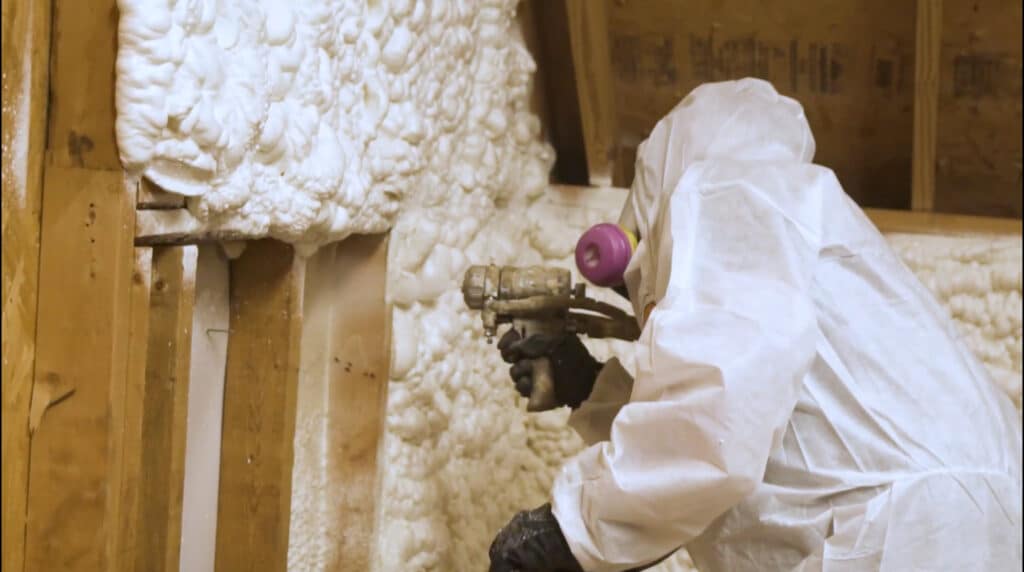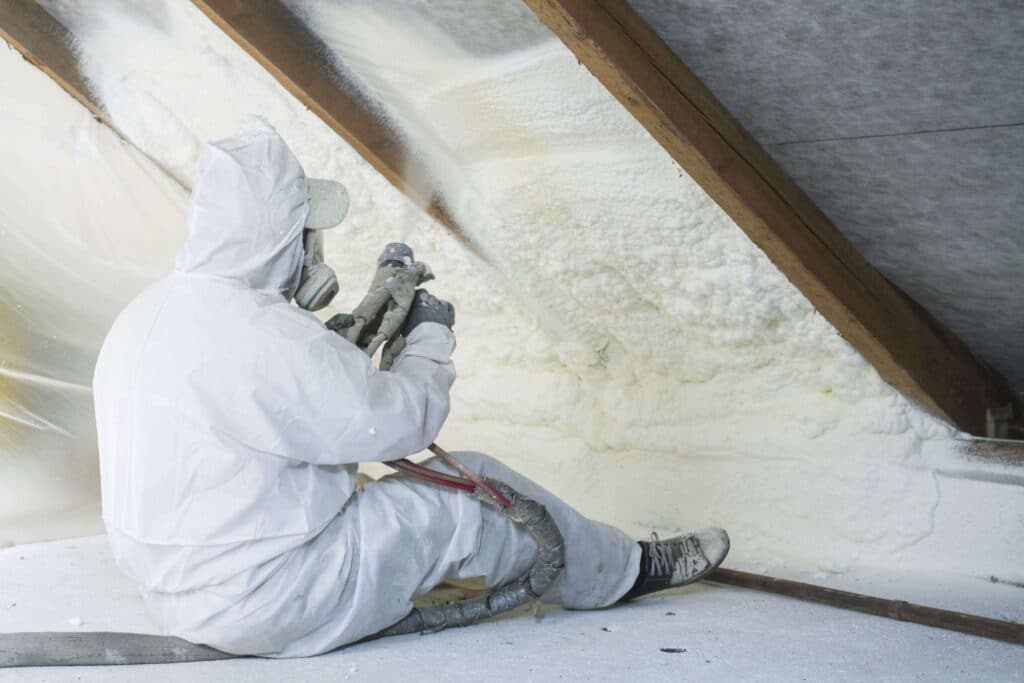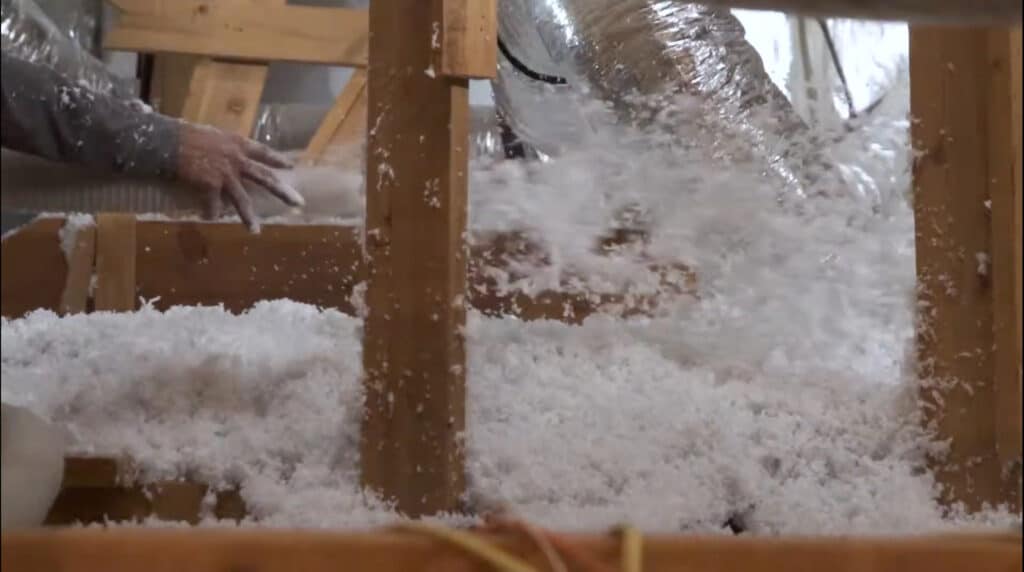Thinking about giving your attic an upgrade? Spray foam attic insulation could be the solution you need. It is known for its ability to significantly enhance energy efficiency and help maintain indoor temperatures. If you’re tired of high energy bills, spray foam attic insulation is worth considering due to its superior insulating properties. Compared to traditional options, spray foam can offer better protection against air leaks, making your home more comfortable year-round.
One of the main attractions of this insulation is its ability to fill every gap and corner, creating a tight seal in your attic. This means that heat will have a harder time escaping during the winter, while cool air is kept in during the summer. With the right application, your attic system can become a strong barrier against the elements. You’ll also find that spray foam can add an extra layer of protection against moisture, reducing the risk of mold or water damage.
Choosing whether to invest in spray foam attic insulation involves thinking about the long-term benefits for your home. It’s durable and requires little maintenance compared to other types of insulation. With its potential to cut energy costs and improve home comfort, it’s easy to see why many homeowners are making the switch. Consider the pros and cons, understand your needs, and decide if this is the right choice for your attic system.
Benefits of Spray Foam Attic Insulation
Spray foam insulation in your attic offers many advantages. It helps save energy, provides better thermal insulation, and improves the quality of the air inside your home. Each of these benefits is essential to consider if you’re looking to upgrade or are planning new construction.
Improving Energy Efficiency
Spray foam insulation is excellent at reducing energy loss. By creating a barrier in your attic, it keeps warm air in during winter and out during summer. This means your heating and cooling systems work less, saving you money on energy bills.
When installed properly, foam insulation seals gaps and cracks. This reduces drafts and ensures a consistent temperature throughout your home. With better energy performance from installed spray foam insulation, your home stays comfortable year-round, even during extreme weather.
Moreover, spray foam in an attic can help achieve higher R-values. These high R-values make it one of the most effective insulation options available today. It provides superior performance compared to other types, like fiberglass.
Advantages of Closed-Cell Foam
Closed-cell spray foam offers unique benefits for insulating attics. This type of closed cell foam has higher density and is more rigid, providing additional structural support for the attic floor. It can be especially beneficial if your attic has uneven surfaces or needs added strength.
The closed-cell foam acts as a moisture barrier. This feature stops water from getting into your attic and prevents potential mold growth. Keeping the area dry not only protects the insulation but also preserves the structure of your home.
Additionally, closed-cell foam has soundproofing qualities. If your home is located in a noisy area, this type can help reduce noise pollution, providing a quieter living environment.
Enhancing Indoor Air Quality
Spray foam insulation can improve the air quality inside your home by sealing gaps and crevices. This prevents pollutants and allergens, like pollen, from entering. Homes with spray foam insulation experience fewer irritants, making it ideal for allergy sufferers.
The insulation also helps control humidity levels. By doing so, it stops mold and mildew from forming. A dry and well-insulated attic is key to maintaining a healthy living space without excess moisture.
Finally, spray foam insulation reduces air exchange with the outside. This creates a more stable environment where temperature and air quality remain consistent, giving you peace of mind about your indoor air.
Drawbacks of Attic Spray Foam Insulation
Attic spray foam insulation has some downsides. It can present various issues depending on the type used and its application. Understanding these challenges can help you make informed decisions about whether it’s the right choice for your home.
Common Problems With Spray Foam Insulation
Spray foam insulation can sometimes lead to air pocket formation if not applied correctly. This occurs when installers leave gaps due to the irregular shape of attics. These gaps impact the insulation’s effectiveness and can cause energy loss. Another issue is the strong odor during installation. Some residents have reported having to leave their homes temporarily because of persistent smells.
There is also a risk of moisture problems. Improper installation can trap moisture, leading to mold growth and structural problems. It’s crucial to hire experienced professionals to reduce these risks and ensure insulation performs as expected.
Insulation Problems Associated With Spray Foam
Health concerns are a significant drawback of spray foam insulation. The chemicals used can release harmful compounds—blowing agents in spray foam have high global warming potentials. If not adequately ventilated, these can contribute to poor indoor air quality.
Another potential issue is termite damage. Spray foam can cover wooden structures entirely, offering a hidden environment where termites can thrive unnoticed. This makes regular inspection difficult and might lead to unnoticed infestations over time. You should consider these aspects when evaluating spray foam insulation options for your attic.
Open Cell Spray Foam Vs Closed Cell
Open-cell foam is less dense, allowing for better soundproofing but offering less structural support. It’s generally cheaper, but may absorb water if exposed, which isn’t ideal for high-moisture areas. On the other hand, closed-cell foam is denser and provides enhanced structural strength and water resistance. Closed-cell spray foam is usually more expensive but offers better insulation.
Choose the type based on your attic’s specific needs. While open-cell is suitable for sound absorption, closed-cell might be necessary for roofs needing additional water and structural support. Understanding these differences can help you make the best choice for your home’s insulation.
Cost of Attic Spray Foam Insulation

Understanding the expenses involved in attic spray foam insulation can help you plan your budget effectively. This guide covers key factors that influence the cost, potential rebates, and average installation prices.
Factors Influencing The Cost
The cost of installing spray foam in your attic varies due to different factors. Type of spray foam, such as open-cell or closed-cell, impacts pricing. Closed-cell spray foam tends to be more expensive due to its density and insulating power. The total area needing insulation also plays a big part. Larger attics require more material and labor, increasing the overall project cost. Location can affect expenses, as installation rates differ between regions.
Installation conditions can impact costs too. Hard-to-reach areas might require more prep work and specialized labor, adding to expenses. Quality of spray foam can also contribute. Opting for a high-quality foam could lead to higher initial costs, but it often provides better insulation and durability. Research prices for different foam options to make informed decisions.
Insulation Rebate For Spray Foam
Rebates can reduce the cost of spray foam insulation. Governments and energy companies sometimes offer incentives for using energy-efficient methods like spray foam. These rebates aim to promote insulation that cuts energy use and improves building efficiency. You might find rebates vary widely depending on your location, eligibility, and existing energy programs.
To find out if you qualify, check with your local utility providers or consult government websites for information on available rebates. Often, there are specific requirements you must meet, such as using a certified installer for open-cell spray foam. Meeting these criteria can result in significant savings, making your spray foam investment more affordable.
Average Cost of Spray Foam Installation
The average cost of spray foam insulation typically falls between $1,409 and $4,145, with most homeowners spending around $2,756. Prices differ based on type and thickness of the foam used. For an example, the cost of using closed-cell spray foam might range from $1.50 to $2.50 per square board foot, potentially raising total expenses to between $2,250 and $3,750 for a typical attic size.
Remember, these are general estimates, and specific costs could vary based on individual project needs and local labor rates. Getting quotes from multiple contractors can provide a clearer picture of what to expect in your area. This approach ensures you find an option that fits both your budget and insulation needs.
Determining If Your Attic Needs Insulation

Checking if your attic needs insulation involves assessing signs of poor insulation, evaluating the performance of existing materials, and considering different types of spray foam insulation. Each of these factors helps you ensure a more energy-efficient and comfortable home.
Signs of Under-Insulation in Attic Space
Under-insulation can cause noticeable effects in your home. Significant energy loss often occurs through the attic, leading to higher energy bills. If you feel temperature fluctuations between rooms, it might mean your attic isn’t well-insulated. Drafts are another symptom, often noticeable around doors and windows.
Ice dams forming on the roof in winter indicate warm air escaping through your attic. Increased noise levels from outside or other parts of your house could also be a sign. Monitoring these signs helps identify insulation needs early, reducing energy costs and improving comfort.
Assessing The Efficiency of Old Insulation
Old insulation materials lose effectiveness over time. You should check for visible wear, like cracks or sagging spots. If moisture or pests have damaged your current insulation, replacement might be necessary. Observe any change in thermal comfort and energy bills, as these could hint at its diminished performance.
Perform a touch test by feeling cold spots on walls and ceilings, which suggest inadequate insulation. Keeping records of your house’s energy use can also aid in assessing its efficiency over time. Professional home energy audits may be considered for reassurance and expert advice on the insulation’s condition.
Types of Spray Foam Insulation Available
There are two main types of spray foam insulation: open-cell and closed-cell. Open-cell foam has a lower R-value, usually around R-3.6 to R-4.3 per inch. It is more flexible and works well for indoor soundproofing. Closed-cell foam is denser and has a higher R-value of R-6 to R-8 per inch.
Closed-cell foam provides better moisture resistance and structural support. Choosing between these types depends on budget, specific insulation needs, and local climate conditions. Professional installation is typically recommended to ensure correct application and energy efficiency benefits. Each type offers unique advantages, enhancing the attic space’s comfort and durability.
Process of Insulating An Attic With Spray Foam
Using spray foam to insulate your attic can save energy and keep your home comfortable. You’ll want to know the steps involved and how to stay safe during the process. Proper application ensures the best performance of the insulation.
Steps Involved In Spraying The Foam
Begin by preparing the attic area for installing spray foam insulation. Clear out any debris or items that might be in the way. Ensure that surfaces are clean and dry before applying the foam. Correctly estimating the amount of spray foam needed is crucial, so measure your attic space carefully.
Shake the foam canister well, then begin applying. Start spraying in edges and corners to create an air seal. Work systematically across the attic. Apply the foam in layers, allowing each to expand and settle before the next. This helps with even coverage and avoids over-application. Inspect your work to ensure no gaps or thin spots.
Safety Precautions
When working with spray foam, always wear protective gear. Eye protection, masks, and gloves are essential. Ensure proper ventilation in the attic space to prevent inhalation of fumes from the foam insulation installed. Avoid skin contact by wearing long sleeves and pants.
Be aware of the surroundings. Make sure there is no open flame or sparks in the area, as some foams are flammable. Inform anyone nearby about your plans to prevent unintentional exposure. Follow the manufacturer’s safety instructions to minimize risks while working.
Proper Application of Insulation for your Home
Ensuring proper application of spray foam is essential for the insulation to work effectively. Begin by testing a small area to understand how the foam behaves and expands. This can prevent mistakes during the larger application.
Aim for an even thickness across all surfaces to maximize efficiency. Address any uneven areas or gaps immediately, as these can compromise insulation quality. Once finished, allow the foam to cure completely before touching or modifying the area further.
Regularly monitor the attic for any signs of cracked or deteriorating foam. Address any issues promptly to maintain proper insulation. This good maintenance practice helps the insulation last longer and perform better.
Alternatives To Spray Foam Insulation For The Attic

When considering attic insulation options, there are several alternatives to spray foam that you might find appealing. These alternatives can offer benefits such as lower costs, ease of installation, and varying levels of thermal efficiency.
Benefits of Fiberglass Insulation
Fiberglass insulation is a popular choice due to its affordability and effectiveness in regulating temperature. It comes in rolls or batts and is easy to install in the floor of the attic.
One of its major advantages is that it does not shrink or settle over time, maintaining its insulating properties. Fiberglass is also fire resistant, providing an added level of safety for your home. Additionally, it discourages mold growth, contributing to a healthier indoor environment.
Cellulose Insulation Vs Spray Foam
Cellulose insulation is made from recycled paper products and treated with fire retardants. It’s known for being eco-friendly and often costs less than spray foam insulation. Unlike fiberglass, cellulose can fill small gaps and spaces, improving its coverage.
Cellulose has a lower R-value compared to spray foam, meaning it may not insulate as well per inch. However, its recycled content and environmental benefits make it an appealing option for those looking to reduce their carbon footprint while insulating the attic.
Pros and Cons of Traditional Insulation Types
Traditional insulation types, such as mineral wool and rigid foam boards, present different advantages. Mineral wool is moisture resistant and has soundproofing qualities, making it a good choice for homes in noisy areas. Rigid foam boards offer high insulating values with minimal thickness, which is useful in tight spaces.
However, these types can be more difficult to install and might not be as flexible in fitting unusual attic shapes. Consider your attic’s specific needs, including space and budget, when deciding whether these traditional types could be right for you.
Frequently Asked Questions
Spray foam insulation is popular for attics, offering benefits like improved insulation value and energy efficiency. Despite its advantages, it may have some drawbacks and considerations, such as potential roadblocks with lenders and varying installation costs.
-
Is spray foam insulation good for attics?
Is spray foam insulation good for attics?
Spray foam insulation can be effective in attics because it expands to fill gaps, reducing air leaks. It helps to maintain consistent temperatures and increases energy efficiency when foam insulation is installed properly. It is also known for providing a moisture barrier, which can prevent mold growth. -
What are the negatives of spray foam insulation?
One issue with spray foam is the initial cost, which can be more expensive compared to other insulation types. Improper installation may lead to trapped moisture, potentially causing structural damage. Some people are also concerned about chemical emissions during installation.
-
Why is spray foam a red flag for lenders?
Lenders might worry about spray foam because improper installation can cause structural issues. The foam can hide roof leaks until they become serious. This potential damage could lead to expensive repairs, making properties with spray foam insulation riskier investments in the eyes of lenders.
-
How much does it cost to spray foam an attic?
The cost to spray foam an attic varies depending on the size of the space and the type of foam used. Closed-cell foam tends to be more expensive than open-cell. Installation rates can range widely, so it’s important to get quotes from several contractors for accurate pricing.
